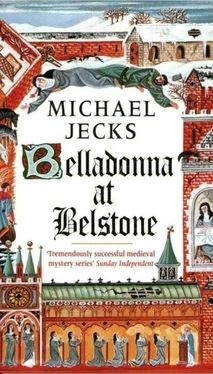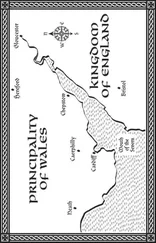Michael Jecks
BELLADONNA AT BELSTONE
1999
The village of Belstone sits high on the moors overlooking the deep valley that separates it from Cosdon, the massive hill that is visible from almost anywhere in northern Devon. I have known the area for years, for my brother and I visit it each New Year’s Day, and walk with wives and families down south to the moors.
It was this year, 1999, that we went to walk down towards the stream, and while strolling among a heavy clitter, I mused it was much like so many spots where monks and nuns chose to site their convents, an idle thought that eventually gave rise to this story. I invented St Mary’s.
Nowadays we think of abbeys and priories being set in delightful places, almost invariably among trees, with lush vegetation and parkland all around. That’s because since the Dissolution, many have been converted into houses and gardens, their lands cultivated over centuries. Beforehand they were often wild, remote, cold and bleak. It’s true that in sunshine they are beautifully romantic ruins, but that is because we visit them on holidays when the summer sun warms us and the ancient nature of the wrecks can give us a comfortable sense of the passing of the years. Yet for all the delights of the larger ecclesiastical holdings at Rievaulx, Westminster, York, Fountains and Whitby, many others sprang up and disappeared, unable to support their communities with their poor and scrubby land. The two years of famine (1315-17) speeded the end of some of these, as did the two murrains or plagues, first of sheep (1313-17) and then of cattle (1319-21), which devastated the English economy. Smaller, less financially viable convents were swallowed up by wealthier ones. Some of these monastic buildings can be traced on the ground, but their walls have been ravaged by time and their stones removed by farmers who wouldn’t pay for dressed stone when it was lying nearby. Many have simply vanished without trace.
When you look back, you find that the obedientiaries – the nuns or monks – had a miserable time of it. Woken for the first service at some time between midnight and 2.30 a.m., they had to go to their church in their rough woollen clothing and stand for an hour or more in the freezing cold, trying to sound musical as they went through the psalms and prayers. There was no fire nor any other means of heating, and in the winter it must have been sheer hell. Not all convents could afford glass in their windows, either.
That was part of the trouble: money. In the late 1200s there was a rapid increase in the number of men and women taking up the religious life, and many convents started to accumulate money from patrons so that they could expand, but many simply couldn’t: they didn’t have the finance behind them. That was why in the early 1300s many places, as I have outlined in this book, went to great lengths to acquire parish churches so that they could use the revenues. Some, like the convent at Polsloe, greatly increased in size, but others failed to win the money and faded away long before the Dissolution.
Nuns found it particularly difficult to support themselves. The reason was simple: when a rich man died he wanted to ensure that his soul had as smooth a passage into heaven as possible, and to this end, he would set up a chantry . This was a chapel which was dedicated to honouring the dead man, holding services and praying for him every day. Depending on how wealthy the man was, the more prayers he could buy; the more prayers said for him, so the logic went, the faster he’d be let in through the Pearly Gates.
But there were problems for nuns: first, nunneries tended to depend upon the goodwill of their strong neighbours, and so they would sometimes agree to take in their neighbours’ daughters in exchange for benefits, such as money, which inevitably led to many of the convents having too many inmates for their means. The risk of over-filling nunneries was recognised at all levels within the Church, and not only bishops but popes too sent letters to convents forbidding them to take on any more nuns.
The second issue was still more difficult to resolve. A man wishing to set up a chantry wanted services held in his memory, but this was a time when no woman could hold a religious service, so nuns had to acquire their own priests, and what would be the point of endowing a religious Order which couldn’t even hold its own ceremonies? Men were more happy leaving their charities to male institutions: the force of monkish prayers was bound to have a greater impact than those of a bunch of women!
Some readers may be surprised to see that I have created a priory with men and women, but this was more or less the norm. As I mentioned above, there had to be priests to conduct services, but also, although nuns were supposed to be completely hidden from the outside world and although they did have lay sisters to do the more mundane work like washing and ironing, they generally had to have men about the place. Men farmed; men tended the buildings; men saw to the religious services; men guarded the gates to the precincts. It was true that most of the nuns were segregated and should never have been tempted by a male form, but that did not work for them all. For one thing, the priory’s bailiffs, reeves, receivers and other senior officials would have been men, and all had to report to the prioress. That was why it was not uncommon to hear rumours of impropriety between prioress and her chief steward. They got to meet.
Tales of nuns misbehaving are not new, and many such stories are no doubt apocryphal, but it has to be accepted that some were true.
Young girls were thrown into their nunneries without any thought for them or their needs. No doubt some would have learned obedience, and in an age when women were possessions to be used as their menfolk saw fit, perhaps some were content. Yet this does not mean that all of them would have been happy with their lot, and records prove that many nuns were not chaste and a large number ran away. The nun of Watton was not unique, and no, I didn’t make up her story. Likewise the collapsing of roofs was not unknown – at Morton the abbess allowed the church roof and the roof of the dorter to fall in. Funds which should have been used to repair them were squandered instead on Master Bryce, the vicar.
When nuns did run away, they were often sought. If found, errant nuns were sometimes treated with respect and sympathy, but once back in their convents, they would be forced to undergo a penance before being set back to work. And all too often these desperate, sad women would try to escape again. Several have been recorded as having thrown off their religious robes, committing the act of apostasy which so horrified their sisters, rejecting all the vows which made sense of their secluded lives. And yet their lives weren’t unremittingly miserable. For those who lived in a great convent, they might have been chilly, but so they would have been in any great hall; they almost certainly lived a great deal longer than their counterparts outside the nunnery; and if the quantity of food wasn’t always enough, a nun would have access to ale or wine, there would always be a good fire roaring in the calefactory, and at least there would be no fear of rape or murder by a drunk at the roadside, nor an early death from childbirth.
If any readers wish to find out more about the lives of medieval nuns, I can heartily recommend Colin Piatt’s The Abbeys and Priories of Medieval England and his Medieval England – A Social History and Archaeology from the Conquest to 1600 AD . It is always difficult to recreate life as it might have been, and any errors in this novel are entirely my own. All I can do is claim the best of intentions.
Читать дальше












